 W
WA pumpkin is a cultivar of winter squash that is round with smooth, slightly ribbed skin, and is most often deep yellow to orange in coloration. The thick shell contains the seeds and pulp. The name is most commonly used for cultivars of Cucurbita pepo, but some cultivars of Cucurbita maxima, C. argyrosperma, and C. moschata with similar appearance are also sometimes called "pumpkin".
 W
WAcorn squash, also called pepper squash or Des Moines squash, is a winter squash with distinctive longitudinal ridges on its exterior and sweet, yellow-orange flesh inside. Although considered a winter squash, acorn squash belongs to the same species as all summer squashes.
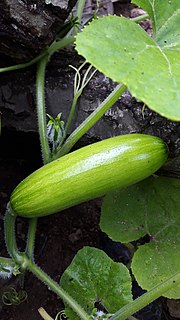 W
WAehobak, also called Korean zucchini or Korean courgette, is an edible, green to yellow-green summer squash. Although nearly all summer squashes are varieties of Cucurbita pepo, aehobak belongs to the species Cucurbita moschata. Commonly used in Korean cuisine, an aehobak has the shape of zucchini, but with thinner, smoother skin, and more delicate flesh. It is usually sold in shrink-wrapped plastic.
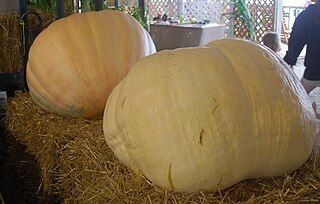 W
WBig Max is a large variety of pumpkin of the species Cucurbita maxima that can exceed 100 pounds (45 kg) and 20 in (510 mm) in diameter under ideal growing conditions. They are often bright orange in color, with fine-grained, yellow-orange flesh. The skin, deeply ribbed and slightly roughened, can grow to be 3 to 4 in thick, making them favorable for storage. The flesh has been described as good for canning and freezing. However, their size often makes utilizing them for culinary uses cumbersome, and they lack the flavor and texture present in smaller pumpkin varieties.
 W
WButternut squash, known in Australia and New Zealand as butternut pumpkin or gramma, is a type of winter squash that grows on a vine. It has a sweet, nutty taste similar to that of a pumpkin. It has tan-yellow skin and orange fleshy pulp with a compartment of seeds in the blossom end. When ripe, it turns increasingly deep orange, and becomes sweeter and richer. It is a good source of fiber, vitamin C, magnesium, and potassium; and it is a source of vitamin A.
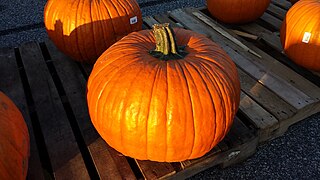 W
WThe Connecticut field pumpkin is a type of pumpkin. It is an heirloom variety, the "standard" and "classic" pumpkin, "one of the oldest pumpkins in existence". Widely used for autumn decorations, either whole or as jack-o'-lanterns, it is also suitable for culinary purposes, but not preferable. Said to differ little from winter squash grown by Native Americans in pre-Columbian times, the name "Connecticut field" references the area where the ancestral variety was found, as well as the traditional system of planting pumpkins in corn fields.
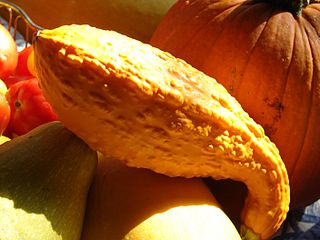 W
WCrookneck squash, also known as yellow squash, is a cultivar of Cucurbita pepo, the species that also includes some pumpkins and most other summer squashes. The plants are bushy and do not spread like the plants of winter squash and pumpkin. Most often used as a summer squash, it is characterized by its yellow skin and sweet yellow flesh, as well as its distinctive curved stem-end or "crooked neck". It should not be confused with crookneck cultivars of Cucurbita moschata, such as the winter squash 'Golden Cushaw', or the vining summer squash 'Tromboncino'. Its name distinguishes it from another similar-looking variety of C. pepo, the straightneck squash, which is also usually yellow. There is one similar non-edible C. pepo variety: C. pepo var. ovifera.
 W
WCucurbita is a genus of herbaceous vines in the gourd family, Cucurbitaceae native to the Andes and Mesoamerica. Five species are grown worldwide for their edible fruit, variously known as squash, pumpkin, or gourd, depending on species, variety, and local parlance, and for their seeds. Other kinds of gourd, also called bottle-gourds, are native to Africa and belong to the genus Lagenaria, which is in the same family and subfamily as Cucurbita, but in a different tribe. These other gourds are used as utensils or vessels, and their young fruits are eaten much like those of Cucurbita species.
 W
WCucurbita andreana is a plant species of the genus Cucurbita, since 1982 in the rank of a C. maxima subspecies, C. maxima subsp. andreana, the wild relative of C. maxima subsp. maxima cultivated subspecies. It is native to Argentina and Uruguay. C. andreana fruits are smaller and not palatable, those of C. maxima are bigger and palatable.
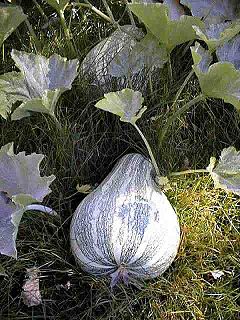 W
WCucurbita argyrosperma, also the Japanese pie pumpkin or cushaw pumpkin, and silver-seed gourd, is a species of winter squash originally from the south of Mexico. This annual herbaceous plant is cultivated in the Americas for its nutritional value: its flowers, shoots, and fruits are all harvested, but it is cultivated most of all for its seeds, which are used for sauces. It was formerly known as Cucurbita mixta.
 W
WCucurbita digitata is a species of flowering plant in the squash family known by the common names fingerleaf gourd and bitter squash. It is similar to Cucurbita californica, Cucurbita cordata, Cucurbita cylindrata, and Cucurbita palmata and all these species hybridize readily. These species form the only restricted xerophyte species group in the genus Cucurbita. Each member of this species group is native to the Southwestern United States and Northwestern Mexico where they are relatively uncommon. Each group member is found in hot, arid regions with low rainfall. They prefer soil that is loose, gravelly, and well-drained. C. digitata is native to northern Baja California at higher elevations, northern Sonora, Mexico, southern Arizona, and southwestern New Mexico. The juvenile leaves of C. cylindrata, C. cordata, C. digitata, and C. palmata show a high degree of similarity, but their mature leaves are visibly different, as are their root structures. C. palmata and C. digitata are sympatric, with C. palmata separating the ranges of C. digitata at the juncture of Baja California, California, and Arizona. C. digitata fruits are clear green mottle that turns yellow at maturity, striped, and round.
 W
WCucurbita ecuadorensis is a species of squash, discovered in 1965 growing wild in Ecuador. Like most wild gourds and squashes, it is creeping vine and is often found climbing over other vegetation. It has been found only in the western provinces of Guayas and Manabi. There is evidence that it was domesticated in Ecuador around 10,000 years ago, likely for its seeds, but no direct records exist and it is no longer cultivated. It is resistant to many diseases of cultivated Cucurbita species, and has been used to breed resistance to several diseases into common squashes. For example, researchers at Cornell University used Cucurbita ecuadorensis to breed resistance to papaya ringspot virus, watermelon mosaic virus, and powdery mildew, into common Cucurbita maxima cultivars. Cucurbita ecuadorensis is listed on the IUCN Red List as vulnerable, and is found protected in the Machalilla National Park.
 W
WCucurbita ficifolia is a species of squash, grown for its edible seeds, fruit, and greens. It has many common names in English such as the fig-leaf gourd, Malabar gourd, black seed squash and cidra. Although it is closely related to other squashes in its genus, such as the pumpkin, it shows considerable biochemical difference from them and does not hybridize readily with them.
 W
WCucurbita foetidissima is a tuberous xerophytic plant found in the central and southwestern United States and northern Mexico. It has numerous common names, including: buffalo gourd, calabazilla, chilicote, coyote gourd, fetid gourd, fetid wild pumpkin, Missouri gourd, prairie gourd, stinking gourd, wild gourd, and wild pumpkin. The type specimen was collected from Mexico by Alexander von Humboldt and Aimé Bonpland sometime before 1817.
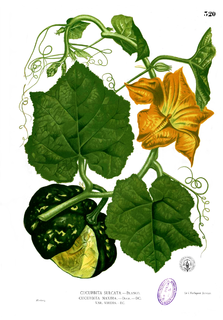 W
WCucurbita maxima, one of at least four species of cultivated squash, is one of the most diverse domesticated species. This species originated in South America from the wild Cucurbita andreana over 4000 years ago. The two species hybridize quite readily but have noticeably different calcium levels.
 W
WCucurbita moschata is a species originating in either Central America or northern South America. It includes cultivars known as squash or pumpkin. C. moschata cultivars are generally more tolerant of hot, humid weather than cultivars of C. maxima or C. pepo. They also generally display a greater resistance to disease and insects, especially to the squash vine borer. Commercially made pumpkin pie mix is most often made from varieties of C. moschata. The ancestral species of the genus Cucurbita were present in the Americas before the arrival of humans. Evolutionarily speaking the genus is relatively recent in origin as no species within the genus is genetically isolated from all the other species. C. moschata acts as the genetic bridge within the genus and is closest to the genus' progenitor.
 W
WCucurbita okeechobeensis, the Okeechobee gourd, is a species of gourd in the family Cucurbitaceae, native to Mexico and the United States. There are two subspecies; one is endemic to Florida, primarily in the region around Lake Okeechobee, the other to the State of Veracruz in eastern Mexico. Once abundant, it has state and federal listing as an endangered species.
 W
WCucurbita palmata is a species of flowering plant in the squash family known by the common names coyote melon and coyote gourd. It is similar to Cucurbita californica, Cucurbita cordata, Cucurbita cylindrata, and Cucurbita digitata and all these species hybridize readily. It was first identified by Sereno Watson in 1876. These species form the only restricted xerophyte species group in the genus Cucurbita. Each member of this species group is native to the Southwestern United States and Northwestern Mexico where they are relatively uncommon. Each group member is found in hot, arid regions with low rainfall. They prefer soil that is loose, gravelly, and well-drained. C. palmata is native to northeastern Baja California, southeastern California, and southwestern Arizona to a point near the Colorado River. The juvenile leaves of C. cylindrata, C. cordata, C. digitata, and C. palmata show a high degree of similarity, but their mature leaves are visibly different, as are their root structures. C. palmata and C. digitata are sympatric, with C. palmata separating the ranges of C. digitata at the juncture of Baja California, California, and Arizona. C. palmata fruits are diffuse green mottle that turns yellow at maturity, striped, and round.
 W
WCucurbita pepo is a cultivated plant of the genus Cucurbita. It yields varieties of winter squash and pumpkin, but the most widespread varieties belong to the subspecies Cucurbita pepo subsp. pepo, called summer squash.
 W
WCucurbita texana, also known as Cucurbita pepo subsp. texana and Texas gourd, is a mesophytic plant species of the genus Cucurbita. It is native to Texas, primarily the southeastern region. It is found only in the wild. It is possibly a progenitor and close relative of the domesticated species Cucurbita pepo, though it and wild C. pepo are native to different areas. Cucurbita fraterna is also closely related. It was first collected 1835 by J. L. Berlandier in southern Texas. It was formally described as Tristemon texanus by George Heinrich Adolf Scheele in 1848 and transferred to the genus Cucurbita by Asa Gray in 1850.
 W
WDelicata squash is a variety of winter squash with cream-coloured cylindrical fruits striped in green or orange that are cooked. As its name suggests, it has characteristically a delicate rind. It is also known as peanut squash, Bohemian squash, or sweet potato squash. It is a cultivar of the species Cucurbita pepo, which also includes the summer squash varieties pattypan squash, zucchini, and yellow crookneck squash, as well as winter squash varieties including acorn squash, spaghetti squash, and most pumpkins used as Jack-o-lanterns.
Gem squash is a variety of summer squash that was domesticated from two wild varieties; Cucurbita texana found in the southern and central United States and Cucurbita fraterna found in Mexico. The dark green spherical fruit, when fully ripe, is about the size of a softball. The young fruit is often harvested before it is ripe due to its having a more delicate flavor and texture.
 W
WA giant pumpkin is an orange fruit of the squash C. maxima commonly weighing from 150 pounds to over one ton.
 W
WHitlerszalonna or Hitler-szalonna was a dense fruit jam, although there is debate about how much fruit was actually in it and how edible it was, that was eaten by Hungarian troops and civilians during World War II. It was made from mixed fruits such as plum and sold in brick shaped blocks held in a piece of paper rather than in a jar. These slabs were sliced, a bit like szalonna. Soldiers kept it in a case and it could be cooked with other foods. The term itself is considered slang and defined as something like "tough fruit".
 W
WHoneynut squash is a winter squash cultivar bred from butternut and buttercup squash. It has a similar shape and flavor to butternut squash but averages about half the size and is significantly sweeter. It has dark tan to orange skin and orange fleshy pulp. When ripe, it turns from green to a deep orange and becomes sweeter and richer. It has two to three times more beta-carotene than butternut squash. Although technically a fruit, honeynut squash is used as a vegetable that can be roasted, sautéed, puréed, added to soups, stews, and braises, and is suitably sweet for desserts.
 W
WA jack-o'-lantern is a carved pumpkin, turnip, or other root vegetable lantern associated with Halloween. Its name comes from the phenomenon of a strange light flickering over peat bogs, called will-o'-the-wisp or jack-o'-lantern. The name is also tied to the Irish legend of Stingy Jack, a drunkard who bargains with Satan and is doomed to roam the Earth with only a hollowed turnip to light his way.
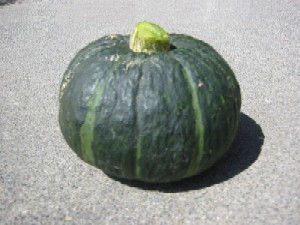 W
WKabocha is a type of winter squash, a Japanese variety of the species Cucurbita maxima. It is also called kabocha squash or Japanese pumpkin in North America. In Japan, "kabocha" may refer to either this squash, to the Western pumpkin, or indeed to other squashes.
 W
WKamokamo is a variety of Cucurbita pepo grown in New Zealand that is thought to have been introduced during early European settlement, around the late 1800s to early 1900s. The name comes from the Māori language.
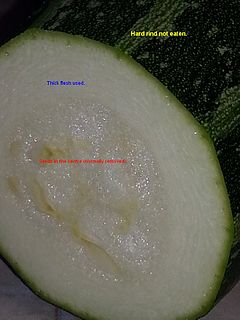 W
WA marrow is a vegetable, the mature fruit of certain Cucurbita pepo cultivars. The immature fruit of the same or similar cultivars is called courgette or zucchini. Like courgettes, marrows are oblong, green squash, but marrows have a firm rind and a neutral flavour, making them useful as edible casings for mincemeat and other stuffings. They can be stored for several weeks after harvest, to be processed for food when required. They are a vegetable used in Great Britain and areas with significant British influence, though their popularity is waning in favor of immature summer squash like courgette.
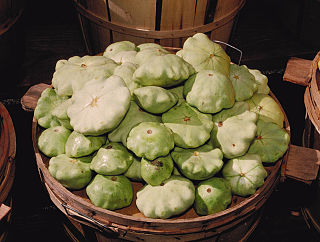 W
WPattypan squash is a variety of summer squash notable for its small size, round and shallow shape, and scalloped edges, somewhat resembling a small toy top, or flying saucer. The name "pattypan" derives from "a pan for baking a patty". Its French name, pâtisson, derives from a Provençal word for a cake made in a scalloped mould. The pattypan squash is also known as scallop squash, peter pan squash, sunburst squash, granny squash, custard marrow, custard squash, ciblème in Cajun French, white squash, button squash, scallopini, or simply "squash" in Australian English, or schwoughksie squash, especially if grown in the Poughkeepsie, New York, area.
 W
WPumpkin chucking, or for rhyming purposes punkin chunkin or pumpkin chunking, is the sport of hurling or 'chucking' a pumpkin solely by mechanical means for distance. The devices used include slingshots, catapults, centrifugals, trebuchets, and pneumatic cannons.
 W
WA pumpkin seed, also known in North America as a pepita, is the edible seed of a pumpkin or certain other cultivars of squash. The seeds are typically flat and asymmetrically oval, have a white outer husk, and are light green in color after the husk is removed. Some cultivars are huskless, and are grown only for their edible seed. The seeds are nutrient- and calorie-rich, with especially high content of fat, protein, dietary fiber, and numerous micronutrients. Pumpkin seed can refer either to the hulled kernel or unhulled whole seed, and most commonly refers to the roasted end product used as a snack.
 W
WRed kuri squash is a thin skinned orange colored winter squash, a cultivated variety of the species Cucurbita maxima. It has the appearance of a small pumpkin without the ridges. It belongs to the Hubbard squash group.
 W
WSpaghetti squash or vegetable spaghetti is a group of cultivars of Cucurbita pepo subsp. pepo. They are available in a variety of shapes, sizes, and colours, including ivory, yellow and orange, with orange having the highest amount of carotene. Its center contains many large seeds. When raw, the flesh is solid and similar to other raw squash. When cooked, the meat of the fruit falls away from the flesh in ribbons or strands that look like, and are often used as a healthier alternative to, spaghetti.
 W
WTromboncino, also known as zucchetta, is a type of squash most often used as a summer squash. While nearly all summer squash are cultivars of Cucurbita pepo, tromboncino is a cultivar of Cucurbita moschata. The vining growth habit is similar to many winter squashes, but unlike most other summer squash. It is more tolerant to some common summer squash pests, including squash vine borer, squash bugs, and powdery mildew, than the more commonly grown, bushy, C. pepo summer squash cultivars. The plants are slower to start producing than some C. pepo types. The fruit color is usually pale green, fading to beige upon maturity, and it is picked around one foot long for summer squash. It is an heirloom, originally from Liguria, and remains popular throughout Italy and abroad. Tromboncino squash can be left to mature into a winter squash; such is often compared to a watery butternut squash. If left to ripen, the fruits can grow over three feet in length.
 W
WTurban squash, also known as "Turk's turban" or "French turban", is a type of squash most often used as a winter squash. It is an heirloom, predating 1820. A cultivar of Cucurbita maxima, it is closely related to the buttercup squash. It is typically 6 pounds when mature. Colors vary, but are often mottled in shades of orange, green, and white. The squash is used as both a vegetable and as an ornamental gourd. Taste is similar to other C. maxima cultivars, though "not as vibrant," "reminiscent to hazelnut," and "coarse, watery and insipid." Known in the nineteenth century as "the most beautiful in color, and the most worthless in quality, of all the varieties of squash;" More recently, Ian Knauer, author of "The Farm", has described it as "nutty and sweet".
 W
WVampire pumpkins and watermelons are a folk legend from the Balkans, in southeastern Europe, described by ethnologist Tatomir Vukanović. The story is associated with the Romani people of the region, from whom much of traditional vampire folklore originated.
 W
WWinter squash is an annual fruit representing several squash species within the genus Cucurbita. It differs from summer squash in that it is harvested and eaten in the mature fruit stage when the seeds within have matured fully and the skin has hardened into a tough rind. At this stage, most varieties of this fruit can be stored for use during the winter. Winter squash is generally cooked before being eaten, and the skin or rind is not usually eaten as it is with summer squash.
 W
WThe zucchini or courgette is a summer squash, of Mesoamerican origin, which can reach nearly 1 metre in length, but is usually harvested when still immature at about 15 to 25 cm. A zucchini is a thin-skinned cultivar of what in Britain and Ireland is referred to as a marrow. In South Africa, zucchini is known as baby marrow.